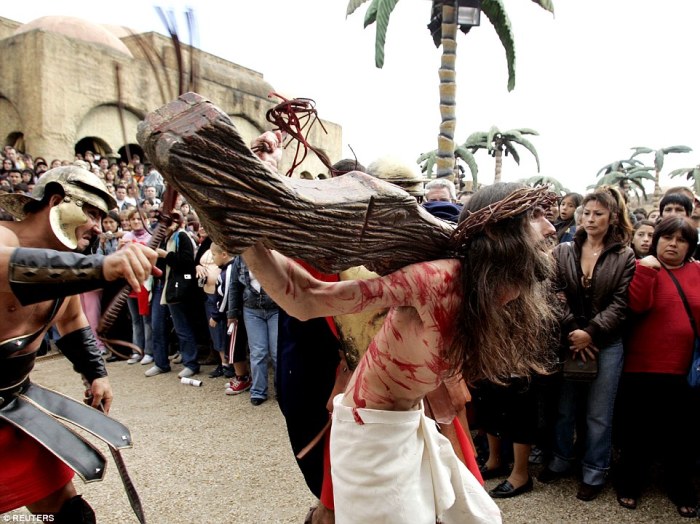Jesus' Crucifixion Described in Graphic Detail by Physician in Lee Strobel's book, 'The Case for Christ'
'

Christ's crucifixion was an act of sheer brutality and barbarism, yet many people today still don't know the horrific details of the physical torture He suffered at the hands of Roman soldiers.
In the recently updated version of his New York Times best-seller The Case for Christ: A Journalist's Personal Investigation of the Evidence for Jesus, Lee Strobel, a Christian apologist and former legal journalist for the Chicago Tribune, teamed up with Dr. Alexander Metherell to walk readers through the gruesome details of Christ's torture and crucifixion, and describe what His physical body endured before he died.
The torture inflicted on Christ was so intense that at the time, no word existed that could capture the essence of His suffering.
Today, the word that attempts to do so is "excruciating."
"I believe it is [derived] from Latin (excruciare/crucify), so it would've been later [after the crucifixion] that this word was invented," Strobel told The Christian Post in a recent interview.
He explained that the word was invented to capture extreme pain and suffering, and literally means "out of the Cross."
Metherell, a sought-after expert who holds a medical degree from the University of Miami in Florida, homed in on various aspects of Jesus' death in Strobel's book.
Some people may have a general understanding of how Christ was tortured. Maybe they've seen the 2004 film "The Passion of the Christ" — which depicts how the Savior suffered, bled, and died for mankind — and figure they have seen all that they need to know regarding the extent of His pain. The following details from Metherell, however, just might make them think twice.
In The Case for Christ, Strobel says Metherell explains that Jesus had likely been close to death before He reached the Cross. "As the flogging continued, the lacerations would tear into the underlying skeletal muscles and produce quivering ribbons of bleeding flesh."
When Christ prayed in the Garden of Gethsemane before he was captured, he sweated blood out of distress about the crucifixion. "This is a known medical condition called hematidrosis. It's not very common, but it is associated with a high degree of psychological stress," Metherell adds.
"What this did was set up the skin to be extremely fragile so that when Jesus was flogged by the Roman soldier the next day, his skin would be very, very sensitive. Roman floggings were known to be terribly brutal. They usually consisted of 39 lashes but frequently were a lot more than that ...
"The soldier would use a whip of braided leather thongs with metal balls woven into them," he continued. "When the whip would strike the flesh, these balls would cause deep bruises or contusions, which would break open with further blows. And the whip had pieces of sharp bone as well which would cut the flesh severely.
"The back would be so shredded that part of the spine was sometimes exposed by the deep, deep cuts. The whipping would have gone all the way from the shoulders down to the back, the buttocks, and the back of the legs. It was just terrible.
"A third century historian by the name of Eusebius described a flogging by saying, 'The sufferer's veins were laid bare and the very muscles, sinews and bowels of the victim were open to exposure.'"
Metherell adds, "We know that many people would die from this kind of beating even before they could be crucified."
But Christ survived, only to face more suffering on the Cross.
Metherell then provides further medical analysis as he describes the site of the Cross where there was a vertical beam already in the ground. The Romans then drove tapered spikes through Christ's wrists, attaching Him to a horizontal beam called a patibulum.
"This was a solid position that would lock the hand; if the nails had been driven through the palms, his weight would have caused the skin to tear and he would've fallen off the cross. So the nails went through the wrists. ...
"It's important to understand that the nail would go though the place where the median nerve runs," Metherell says, explaining that this is the largest nerve going out of the hand and would be "crushed" by the pounding nail.
"Do you know the kind of pain you feel when you bang your elbow and hit your funny bone ... well, picture taking a pair of pliers and squeezing (as he twists his hands) and crushing that nerve. The pain was absolutely unbearable." Jesus's feet were nailed and those nerves were similarly crushed.
The doctor explains that Christ's arms would have been stretched 6 inches and his shoulders dislocated.
Strobel notes in his book that Metherell provides explicit details about how Christ died an "agonizingly, slow death by asphyxiation." The doctor explains that the stress on the diaphragm put the chest into an inhaling position and that in order to exhale, Christ would have had to push up using his painful feet in order relieve pressure on the diaphragm and temporarily exhale. "In doing so, the nail would tear through the foot, eventually locking up against the tarsal bones."
Metherell said this breathing motion would go on and on, Christ scraping His shredded back against the coarse wood until He became completely exhausted and unable to push up and breathe.
"As the person slows down his breathing, he goes into what is called respiratory acidosis — the carbon dioxide in the blood is dissolved as carbonic acid, causing the acidity of the blood to increase. This eventually leads to an irregular heart beat."
"In fact, with his heart beating erratically, Jesus would have known that he was at the moment of death, which is when he was able to say, 'Lord, into your hands I commit my spirit.' And then he died of cardiac arrest."





























